Abstract
In the rapidly growing economies of Southeast Asia, energy consumption and energy costs in buildings continue to increase. Over the past decade, energy consumption from the commercial building sector in Thailand has increased at an average of 4% per annum and currently represents over 30% of total electricity consumption, second only to the industrial sector. Buildings that exist today will continue to represent most of both energy and greenhouse gas (GHG) emissions from the built environment, with newly constructed buildings representing only a small additional portion. This paper analyzes the environmental, technical, and financial characteristics of energy efficiency retrofit activities in commercial buildings in Thailand through detailed case studies of forty-two projects undertaken over the past 8 years. Our findings suggest that retrofits provide significant opportunities to reduce energy use, energy costs, and GHG emissions while also validating the economic feasibility of investments into such retrofit activities. Through this detailed analysis of past retrofit projects in Thailand, we found that the marginal abatement costs (MAC) relating to the key energy conservation measures (ECM) implemented within these retrofit projects all have negative costs. However, although these findings demonstrate positive economics and should be sufficient to instigate widespread adoption, in reality, this is not taking place. It is evident that greater public policy and leadership are needed to stimulate growth in the building retrofit sector to take advantage of the opportunities and benefits that building retrofits offer.
1. Introduction
Through targeted initiatives, such as the retrofitting of existing buildings to reduce energy consumption and to improve the overall energy efficiency of major equipment and systems, buildings hold the key to significantly reducing energy and are crucial to a more sustainable future [1,2,3,4]. Buildings are responsible for a significant portion of GHG emissions globally, and the commercial building sector energy consumption represents a significant fraction of the overall energy consumption in urban communities [5,6,7]. Most existing buildings in the past had not considered operational energy consumption when they were built. A large amount was built before adopting modern sustainable design and construction practices [8]. Many of the buildings that will determine the trends in energy consumption in the future already exist, and by undertaking an energy efficiency retrofit, a typical building can realize significant energy savings [1]. According to Grob et al. (2020) [9], one-third of the total building stock in the European Union is older than 50 years, with only about one percent being renovated each year. These retrofits could deliver positive economic benefits in the form of reduced energy and operational costs (positive economic return on investments) in addition to mitigation of CO2 emissions [10,11]. Energy efficiency is also the cheapest way to assist governments in meeting their energy security concerns by reducing their dependence on imported energy. Moreover, energy efficiency is the least-cost approach to reducing negative impacts on the environment and GHG emissions that contribute to global warming [12].
Although there have been significant efforts to develop and deliver building energy efficiency retrofit programs worldwide (the C40 and the Clinton Foundation’s Clinton Climate Initiative), much potential remains because of the presence of multiple, persistent barriers at both the project level and system level. The energy performance of buildings directive (EPBD) in the EU promotes cost-effective building renovation, with the vision of a decarbonized building stock by 2050, outlining the major challenge of renovating millions of existing buildings to improve their energy performance [13]. McKinsey (2010) [14] explains that “by their nature, energy–efficiency measures typically require a substantial upfront investment in exchange for savings that accrue over the lifetime of the deployed measures. Additionally, energy efficiency potential is highly fragmented, spread across multiple locations and numerous systems and technologies used in various settings.” This dispersion virtually ensures that energy efficiency initiatives can only capture a limited mind-share—it is rarely the highest priority for anyone. Finally, measuring and verifying energy use that is “avoided” is itself difficult. Evidence suggests that there is significant potential for cost-effective investment in energy efficiency, yet this potential is still not being realized in full. The existence of market failures and other barriers to energy efficiency means that we still see a relatively low amount of investment into energy efficiency [15,16,17]. Vivatpinyo (2019) [18] explains that to ensure energy security and to cope with the impacts of global warming in Thailand, promoting energy efficiency is one of the essential strategies. At the same time, Chaichaloempreecha (2019) [19] mentions that energy efficiency, along with renewable energy, is the “main mechanisms to diminish GHG emissions in Thailand” and that that in addition to reducing GHG emissions, Thailand will also gain additional co-benefits, including improved energy security and social and economic.
Thailand’s electricity consumption has increased by over 43 percent over the past ten years, with an annual growth rate of approximately 3.67 percent. As shown in Figure 1 the total annual electricity consumption in Thailand was approximately 135,181 Gigawatt hours (GWh) in 2009 and increased to 192,956 GWh in 2019 [20,21]. Electricity consumption of the building sector was 27,855 GWh in 2009 and increased to approximately 49,128 GWh in 2019, showing an average annual increase of 5.91% and has been the most rapidly increasing sector in terms of electricity consumption growth [21]. The Ministry of Energy (2016) [22] projects that the commercial building sector will consume approximately 175,000 GWh of electricity by the year 2036, while according to Misila (2017) [23], it is estimated that under a business-as-usual scenario, Thailand will release 425,649 kilotons of CO2 equivalent (ktCO2e) The buildings sector represents on average approximately 25% of the total electricity consumed in Thailand. This represents approximately 8% of the total energy consumed in Thailand in 2019. In 2017, the commercial building sector represented the second-largest consumer of electricity (24.4%) behind the industrial sector and the third-largest consumer of total final energy consumption (behind industry and transportation) [24].
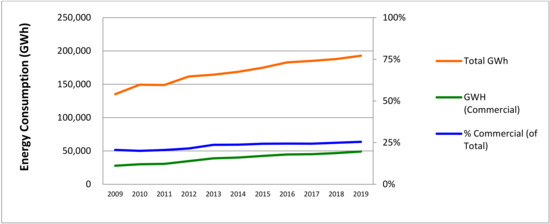
Figure 1.
Total electricity consumption and electricity consumption of the commercial building sector in Thailand 2009–2019 [21,25,26,27].
In April 2013, the Ministry of Energy Thailand launched a 20 year energy efficiency development plan (EEDP) with a target of reducing energy intensity (EI) by 25% by 2030, based upon 2005 as the base year. The EEDP (along with the power development plan and alternative energy development plan) was revised in 2015 to extend up until the year 2036 and was renamed the energy efficiency plan (EEP). The new target is to reduce energy intensity by 30% based upon 2010 figures. This plan includes various measures and activities that aim to reduce approximately 56,142 kilotons of oil equivalent (ktoe) from business-as-usual (BAU) by 2036 [28]. According to the International Energy Agency (2016) [29], under the EEP, Thailand is implementing a package of measures that seeks to save a total of nearly 90 terawatt-hours by 2036. Policy measures contained in the EEP include minimum energy performance standards (MEPS), energy efficiency resource standards (EERS) and energy management systems in buildings. The commercial sector is expected to account for the largest share of energy efficiency improvements (41%). The EEP outlines five strategic approaches to improving energy efficiency, including strengthening and expanding the following:
- I.
- Mandatory requirements with rules, regulations and standards;
- II.
- Energy conservation promotion and support;
- III.
- Public awareness of energy efficiency and behavior change;
- IV.
- Promotion of technology development and innovation;
- V.
- Development of human resources and institutional capacity.
Thailand submitted its nationally determined contributions (NDCs) to the UNFCCC at the Paris Agreement In 2015, pledging that Thailand intends to reduce its GHG emissions by 20 percent from the projected business-as-usual (BAU) level by 2030 [19,30].
In 2018, shopping malls represented the single largest electricity consumer at approximately 5235 GWh, which was equivalent to 8% of the total electricity consumption of the building sector (Figure 2). Hotels and commercial office buildings were next with 4363 (6%) and 2966 GWh (4%), respectively [24]. Shopping malls also have the highest energy intensity among commercial buildings in Thailand, estimated to consume roughly 295 kilowatt hours per square meter per year (kWh/m2/year). Hotels, which consume 255 kWh/m2/year, were second, while commercial office buildings consume approximately 225 kWh/m2/year [31].
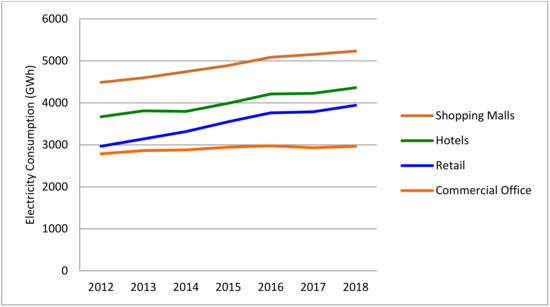
Figure 2.
Total electricity consumption by building type in Thailand 2012–2018 [21].
In this context, this paper aims to provide a deeper understanding of the key performance indicators of energy efficiency retrofit cases in commercial buildings in Thailand through an actual set of case study analyses. The objective is to identify the main parameters from four core domains, the financial, the technical, the environmental, and finally, a combination of the three. The financial component, which is focused on the financing feasibility (return on investment) of commercial building retrofits, is an important part of the formula for better understanding investment and financing requirements. The technical aspect of the analysis focuses on understanding the technical opportunities delivered by individual ECMs, and their distinctive contribution to both energy and energy cost savings in a commercial building retrofit project. In this study, the case studies are assessed based upon their environmental impact by determining their total annual GHG emissions. To assess the relationship between all three components and provide a macro perspective to the research, a marginal abatement cost (MAC) curve is developed to provide insight into the correlation between the financial, technical, and environmental variables of retrofit projects in Thailand. The analysis of the case studies is focused on answering the several key questions relating to energy efficiency retrofits of commercial buildings in Thailand, such as energy savings and energy cost savings per commercial building type, investment amount and the average return on investment (ROI), investment per ton of CO2 reduction, type of building that offers the highest energy CO2 reduction potential, and the ECMs that deliver the highest energy savings, energy cost savings, and CO2 mitigation.
2. Methodology and Data
In this study, research was undertaken on energy efficiency retrofit projects undertaken from 2012–2020 in commercial buildings in Thailand (Table 1). Case studies were identified in the market through key stakeholders, such as the Thailand Department of Alternative Energy Development and Efficiency (DEDE), energy service companies (ESCOs), property owners and managers, and energy efficiency retrofit programs and initiatives, such as the Clinton Foundation’s Energy Efficiency Building Retrofit Program and the Asian Development Bank (ADB) Southeast Asia Energy Efficiency Project. All case studies in this research involved interviews with the building owner/operator, the financing institution supporting the project, the implementing partner, and/or other key stakeholders to obtain key information and data. Secondary sources were also used in the research to verify and supplement information.

Table 1.
Summary of energy efficiency retrofit case studies.
Case studies were selected based upon the following criteria and objectives:
- A.
- Projects that were implemented with a comprehensive approach to energy reduction throughout the building (multiple ECMs);
- B.
- A combination of different commercial building types (offices, hotels, and retail buildings);
- C.
- Availability of sufficient data and information;
- D.
- Availability of post-implementation measurement and verification data (to provide key performance data);
- E.
- Projects (ECMs) that were implemented at the same time through single entities (ESCOs);
Comprehensive data and information on each case study were researched and compiled. The data included key performance indicators, such as:
- Financial:
- a.
- Total investment required to implement the project (USD);
- b.
- Energy cost savings per annum achieved from the project (USD);
- c.
- Payback period (years)*;
- Technical
- a.
- Energy conservation measures (ECMs) implemented;
- b.
- Size—total floor area (m2);
- c.
- Reduction in energy consumption (kWh and percentage);
- Environmental
- a.
- Energy savings per annum (kWh);
- b.
- Tons of GHG emissions were reduced per annum (tCO2e).
* payback period was calculated as (a) divided by (b)
As illustrated by Figure 3 above, a total of forty-two case studies were identified and adopted into the research “database” in MS-EXCEL for analysis. These case studies were assigned into three building type categories—commercial office, hotel, and retail. Key performance indicators for each case study were then compiled under three groups—financial, technical, and environmental to gain a deeper understanding of the core characteristics of each project. The results were then assessed with a focus on five key performance themes. Finally, a MAC curve was developed to provide an insight into the relationship between the GHG emission abatement potential and the cost of each ECM from the respective case studies.
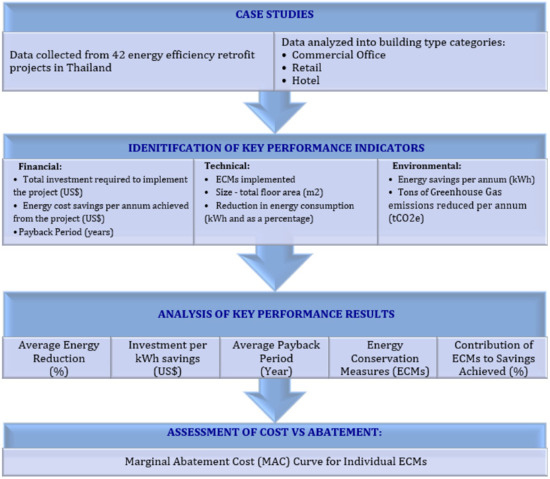
Figure 3.
Summary of the overall methodology.
For the purposes of this research (and in synergy with the Thai Building Energy Code), all buildings exceed 2000 square meters of total floor area. All hotels are rated with a 4 and 5-Star rating, and the retail category focused only on shopping malls. This research sample represents approximately 50% of the total number of projects (similar) implemented in Thailand between 2018 and 2020. Although there were numerous energy efficiency projects implemented in commercial buildings in Thailand over this period, many of them involved the simple replacement of old equipment, and there is limited data available to analyze them in detail.
The following is the formula used for calculating the marginal GHG abatement costs:
A MAC curve provides information on abatement potential and costs relating to that abatement for a set of measures and ranks them according to their cost, from the least to the most expensive. They can be a useful visual tool to compare potential ECMs and prioritize them based on their economic feasibility and potential environmental impact. The MACTool model, developed by the World Bank to build MAC curves, was used for this analysis. Abatement costs can be negative if the cost savings are significant.
The ECMs and the CO2 abatement from each individual energy efficiency retrofit case study were used as inputs to determine the respective MAC. Then, the results from the individual case studies were aggregated together from all case studies to obtain an average MAC, which is representative of each ECM. This enabled a comparison of the performance characteristics of the individual ECMs from the portfolio of case studies. This is a similar methodology to that, which was used in Telsnig et al. 2013 [32] (“static approach”) and the “expert-based MAC” curve [33,34,35]. Each ECM was then inputted into the comprehensive MAC model to compare each ECM with other ECMs (HVAC, lighting, hot water, and building energy management systems). This methodology was used to determine the respective performance of each ECM and plotted on the energy efficiency retrofit MAC curve. The MAC curve was then re-arranged so that individual ECMs were positioned in a hierarchical format from left to right, starting from the lowest cost opportunity. A discount rate of 7% was used in the modeling tool, which was derived from the current financial conditions in Thailand (commercial lending rates). The useful economic life of retrofit projects impacts the total cost of implementing an option (Table 2). To obtain results, which could be applicable to the general commercial building sector in Thailand and respective investment decisions, the MAC analysis was undertaken using the following useful economic life for each ECM:

Table 2.
Useful economic life of ECMs (years).
3. Results and Key Findings
Forty-two energy efficiency retrofit case studies were identified, selected and analyzed. They present key findings related to the existing market characteristics and conditions in Thailand’s commercial building energy efficiency retrofit activities. The majority of the energy efficiency retrofit projects identified and adopted into this research in the commercial building sector in Thailand were undertaken in the hospitality sector, mainly hotels and resorts (28), the retail sector (10), and the commercial office building sector (4). Hotels have comparatively high-energy intensities, usually operate 24 h per day and hence have high utility costs, compared to other commercial buildings and therefore, energy efficiency retrofits often offer a more attractive return on investment and hence are undertaken more frequently than other building types. At the same time, the hospitality industry, in general, has often been a leader in adopting environmental initiatives, especially those, which are part of an international hotel brand with global policies and targets relating to energy consumption, as well as other areas, such as water, waste, wastewater, and overall carbon footprint.
3.1. Average Energy Reduction (%)
The average reduction in energy consumption resulting from energy efficiency retrofit initiatives in commercial buildings in Thailand is 18.13%. The savings ranged from 6.11% to 30.55%. Hotels have the highest average energy reduction at just under 19%, with retail having a slightly lower average at 17.48%, and commercial office buildings at just above 15% (Figure 4).
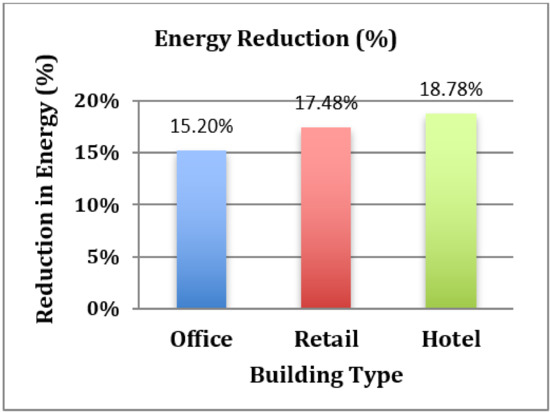
Figure 4.
Average energy reduction achieved (%).
Although there is not a significant variation between the average energy reduction achieved within the sample set of different building types, the results show that the highest reduction can be found within hotels. This may be attributed in part to policies adopted by many of the large hotel chains throughout the world to address (significantly reduce) their overall carbon footprint, often expressing these as individual targets within the energy, water, waste, and wastewater.
3.2. Average Payback Period (Years)
The case studies show that projects that were implemented across the various commercial buildings in Thailand have an average payback period of 4.28 years, with most of them having a payback ranging between 4 to 5 years (Figure 5). These findings are in line with research undertaken in China on 67 energy efficiency projects with building retrofitting payback periods as low as 4 years [1]. Similar to results from other key performance indicators above, both retail and hotel buildings have similar payback periods. Retail projects are averaging paybacks of 4.14 years, while hotel projects deliver a return in 4.25 years (Figure 4). The payback period from energy efficiency projects implemented in commercial office buildings averages slightly below a 5 year period (4.85). These longer payback periods can be attributed to their lower operational intensity compared to the other types of buildings, with commercial offices usually operating approximately 10 to 12 h a day and often only 5 days per week.
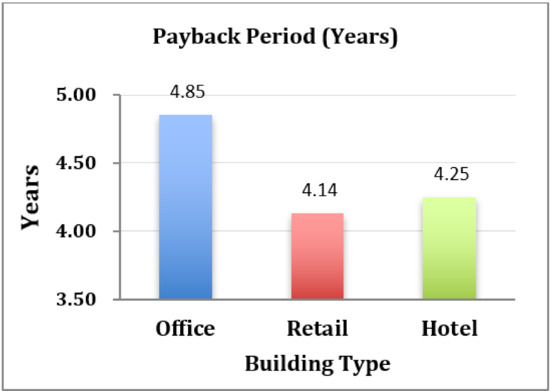
Figure 5.
Payback period (years).
This average payback period helps demonstrate the willingness of building owners (and investors) in Thailand to approve projects, which have payback periods of below 5 years, and hence usually include ECMs, which focus on core equipment and systems, such as HVAC and lighting, while others, such as those, which address the building envelope are excluded because of their longer payback periods. An in-depth look at the relationship between the respective ECMs and the savings delivered (and hence their impact on payback periods) is discussed in the following section. These findings also show that the average payback periods for energy efficiency retrofit projects in Thailand are longer when compared to neighboring countries across Southeast Asia. Payback periods are dependent mainly upon prevailing energy tariffs, and as such, payback periods in Thailand are generally longer than those in the Philippines, Cambodia and Singapore (all of which have higher electricity tariffs) and are similar to those in Vietnam, Malaysia and Indonesia.
3.3. The “Cost to Save”—Investment per kWh of Savings (USD:kWh)
In Thailand, the average tariff for commercial buildings is approximately USD 0.12/kWh. Our analysis shows that the average investment needed to save one kilowatt-hour (kWh) of electricity across all commercial building types is USD 0.38. Both hotels and retail buildings have identical investment requirements (USD 0.37/kWh). Office buildings have a slightly higher investment requirement at USD 0.44/kWh (Figure 6). Although the investment required to save one kWh is approximately 3 times higher than that of the average electricity tariff, over the useful economic life of the different ECMs implemented to deliver these kWh savings, they offer a positive net present value (NPV) and are financially feasible. This finding helps to reiterate the positive economic benefits that can be realized from investing in energy efficiency retrofits in Thailand, as well as countries in the Southeast Asian region, which share similar built environment conditions, especially the major cities and urban areas in the Philippines (Manila), Indonesia (Jakarta), Malaysia Kuala Lumpur, Cambodia (Phnom Penh) and Vietnam (Ho Chi Minh and Hanoi).

Figure 6.
The investment required to deliver savings (USD:kWh).
The comparatively lower energy intensity and the significantly shorter operating hours (and days of the year) of commercial office buildings help to explain the higher investment required to generate one kWh of savings. Within a commercial office building, there are often only a limited number of potential systems to reduce energy consumption (air-conditioning and common area lighting) than hotels where there are several areas and multiple systems in place where energy efficiency can be improved through various ECMs.
3.4. Energy Conservation Measures (ECMs)
For the specific purposes of this research, ECMs were separated into groups, which represent the key technologies found within the various energy efficiency retrofit projects in Thailand across commercial buildings. In a similar context to research undertaken [36,37,38], these technical initiatives were grouped into the following categories: heating ventilation and air conditioning (HVAC), lighting, hot water, building energy management systems (BEMS), and others. The “others” category represents other initiatives, which were not commonly found across the commercial building retrofit projects, but still contributed to the overall energy savings from the projects. ECMs in this category included measures, such as improving the building envelope by increasing insulation, replacing pumps, and installing solar panels. To determine the investment used per ECM Group, the investment required for each ECM was identified and then divided by the total investment.
Our analysis found that although a retrofit project can implement several ECMs together, most of the projects often implemented ECMs in a single technical category, such as ECMs, which focus on air-conditioning, or only lighting) (Table 3). ECMs relating to the HVAC system (such as replacement of chiller, cooling tower optimization, or the installation of Variable Speed Drives, VSDs) are by far the most dominant ECM category for the commercial building energy efficiency retrofit projects in our case study buildings (which in a way representative to entire Thailand), with 73.81% of all projects implementing some ECM relating to the HVAC.

Table 3.
Summary of energy conservation measures (by building type).
Investments into HVAC system improvements represent the largest investment across all building types, often contributing to more than 50% of the total project investment, with several projects allocating 100% of the total investment into ECMs relating to improving the building’s HVAC system. As shown in Figure 7, in retail buildings, where HVAC contributes by far the largest single energy-related cost, more than 60% of the investment comes from measures relating to improving the efficiency of the HVAC (offices and hotel buildings are 45.59% and 39.98%, respectively).
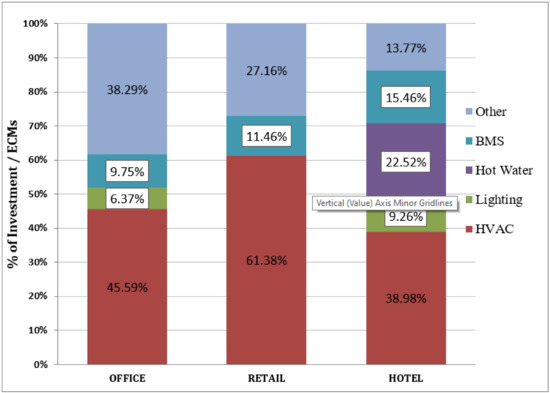
Figure 7.
Proportion of total investment per ECM category (%).
45.24% of all projects implemented ECMs in a single ECM category. This could be attributed to the market characteristics in Thailand, both from the building owners’ perspective and the ESCOs. Most commercial building owners are unfamiliar with energy efficiency technologies and lack the internal resources to evaluate multiple technologies [39]. Hence, they prefer a project with fewer ECMs rather than choosing a larger, more complex project with multiple ECMs. At the same time, this can also reflect the maturity of the energy service company (ESCO) market in Thailand, which is still (and has been for several years) dominated by ESCOs which are specialists in single technology categories and may not have the internal capacity to deliver comprehensive projects, including multiple ECM categories. Panev et al. (2014) [37] describe this as “technical barriers are instead mainly generated from a lack of competency since some companies are quite new to the ESCO market.” According to the same source, most the ESCOs in Thailand are made up of manufacturers and suppliers of technologies, such as heat pumps, variable speed drives (VSDs), lighting systems, and systems for ventilation and air conditioning; and the number of single ESCOs that can perform all of the activities (mentioned above) is limited. Hence, the scope of such energy efficiency retrofit projects is very single-technology, single-ECM focused.
There were also some ECMs, which were very specific to building type. For example, ECMs relating to hot water (such as replacing an existing electric or diesel boiler with a heat pump) were specific only to retrofit projects in hotels (and resorts). In hotels, ECMs relating to hot water improvements represented the second-largest investment at 22.52% (Figure 7). This suggests a direct correlation to the energy use and the number of systems in this respective building type. The energy efficiency retrofit projects, which had the greatest number of ECMs, were in the hotels and resorts. Hotels and resorts often have several energy-consuming systems in place with a combination of various applications (guest rooms, kitchen, laundry, “back of house”, gym, pool) as opposed to commercial office and retail, which are often dominated by a few individual systems.
3.5. Contribution of ECMs to Savings Achieved (%)
The results from undertaking a deeper analysis of the savings delivered from individual ECMs revealed that even when multiple ECMs were implemented across different building categories, ECMs relating to HVAC remained the single most dominant category in terms of energy savings. ECMs within the HVAC category also dominated total estimated energy savings and total energy cost savings. As shown in Figure 8 below, ECMs relating to HVAC deliver the highest proportion of savings compared to all ECMs, and across all three building types. Parallel to the characteristics of the investment assessment, HVAC contributes almost 60% of energy savings in retail buildings, with just over 45% of energy savings in office buildings coming from ECMs in this specific category. In hotel buildings, there is a large opportunity for a reduction in energy consumption in hot water systems. ECMs relating to improving the efficiency of these systems generated on average 25% of total savings achieved (Figure 8).
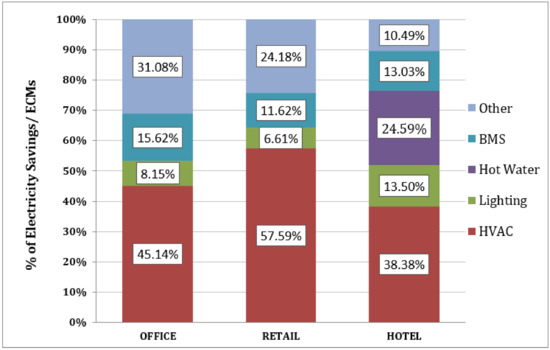
Figure 8.
Proportion of total savings per ECM category.
ECMs in this category often involved the replacement of inefficient boilers running on either electricity or heavy fuel oil with heat pumps (air source). As illustrated in Figure 8, improving (or implementing) a building energy management system (BEMS) delivers energy savings in all building types, averaging savings between 11%, 13% and 15% in retail, hotels, offices and hotels, respectively. According to Taminiau et al. (2021) [40], the control of building operations reported savings in the 10–30% range. However, BEMS were found to be one of the least widely implemented ECMs in the energy efficiency retrofit projects, with only 12% of all projects implementing measures in this category.
3.6. Marginal Abatement Cost Curve for Individual ECMs
To determine the relationship between individual ECM costs and the GHG emission reduction potential of energy efficiency retrofit projects in the commercial building sector in Thailand, a marginal abatement cost (MAC) curve was utilized. This analysis was focused on assessing and comparing the mitigation results of the different ECMs, using the database of retrofit project case studies that were developed in this study. Marginal abatement means the cost to reduce or offset one unit of pollution, in this case, one ton of GHG emissions. MAC curves show the abatement cost, in dollar per ton CO2e reduced achievable by different energy efficiency projects at a given point in time. The height of the vertical axis represents the cost of each of the potential ECMs, while the width of the horizontal axis represents the total abatement potential for each of the ECMs. The widest block delivers the most abatement.
ECM-specific MAC curves have been developed since the early 1990s [41] and have become the interest of a wider audience since McKinsey published assessments of the cost of abatement potentials in the United States [34] and at the global scale [42]. The MAC curve is traditionally used to inform policymakers at a national or even global scale. McKinsey has developed MAC curves for 15 different countries (or regions).
Figure 9 illustrates our key findings from undertaking a marginal abatement analysis of the various ECM categories in building retrofit in Thailand, identified in the case studies. This analysis has been particularly helpful in identifying two core factors essential to better understanding the energy efficiency retrofit market in Thailand. First, it shows, which ECMs have the best financial/economic returns, and second, it shows the CO2 abatement potential in terms of average total potential per ECM category. All of these core building retrofit energy efficiency initiatives (ECMs) delivered negative marginal abatement cost opportunities. These results suggest that, over the life cycle (useful economic life) of each individual ECM in the four categories, the energy cost savings generated were sufficient enough to overcome the initial investment required for the implementation. These results are in line with the global MACC and other findings [43] and the Energy Efficiency MACC for the UK [15].
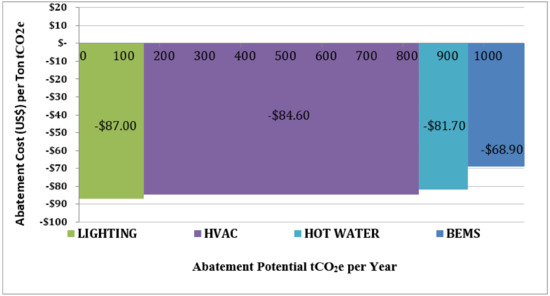
Figure 9.
MAC curve—ECMs in commercial building retrofits in Thailand.
Our analysis of the forty-two various commercial building energy efficiency retrofit case studies in Thailand found that each project delivered an abatement amount of approximately 1020 tCO2e. Figure 4 helps illustrate the overall contribution of each individual ECM category to this total amount. It shows that ECMs relating to HVAC delivers the largest proportion of CO2 abatement, while ECMs relating to lighting have the lowest marginal cost (USD -87), meaning that this ECM category delivers the highest return on investment. The results also show that there is not a large difference between the marginal cost of the three core ECMs that were analyzed, HVAC, Lighting and Hot Water Systems, suggesting that all three of these offer very positive economic results, while the implementation of ECMs relating to BEMS have a slightly higher cost, but are still economically viable investments. ECMs relating to lighting deliver the best marginal cost opportunity, estimated at USD -87.00, HVAC at USD -84.60, Hot Water Systems at USD -81.70, and BEMS at USD -68.90.
On average, energy efficiency initiatives within the HVAC category (such as the replacement of existing chillers with new high-efficiency systems, installing variable speed drives (VSDs) on pumps) have the potential to reduce 660 tons of CO2e per annum per retrofit project. This is approximately 65% of the total abatement potential per project. This is represented in Figure 4 by the combined area “HVAC”. This is a significantly higher amount compared with all other potential initiatives of a commercial building combined together. Although lighting has the highest economic return, it only has an abatement potential of 140 tons of CO2e per annum, while ECMs relating to hot water have not only the lowest potential abatement (120 tons of CO2e per annum) but also are limited to only some commercial buildings where there is hot water consumption (the hospitality sector). BEMS has a potential abatement of 100 tons of CO2e per annum, but its lower economic viability than other ECMs has resulted in these respective measures not being widely implemented in the commercial building sector in Thailand. These findings are in line with other research undertaken on energy efficiency technology abatement costs and opportunities in the existing commercial building sector not only in Asia but in other regions, including South America and South Africa [14,34,40,44,45,46].
The “negative” marginal abatement costs relating to the implementation of energy efficiency technologies, especially those relating to improvements in the efficiency of lighting, HVAC systems, hot water systems, and BEMS, clearly demonstrate that in Thailand, there is not only a positive impact on the environment through reduced GHG emissions but also strong financial feasibility from such investments (over their useful economic lifecycle). In Thailand, it has been found that the marginal abatement cost of ECMs relating to lighting (mostly related to switching from halogen and compact fluorescent lamps to LEDs) is almost identical to the lighting variable in the global GHG abatement cost curve (Table 4). As for HVAC and BEMS, the marginal costs in Thailand have been found to be lower than the global level, suggesting that these two ECMs deliver even higher economic returns and thus suggest an even better return on investment.

Table 4.
Comparison of McKinsey global abatement cost curve with Thailand (per ECM).
4. Conclusions
Commercial buildings consume significant amounts of energy, often representing more than a third of total energy consumption in major capital cities worldwide. Major cities in Thailand are experiencing large growth rates spurred on by continuous urbanization and economic growth. This has been a very evident trend in the Southeast Asian region among most of the major cities and will continue to transpire over the coming decades. Therefore, commercial buildings represent a significant opportunity to reduce energy consumption, energy costs and related GHG emissions all at the same time.
Our findings from the analysis of the energy efficiency retrofit case studies help reveal some principal characteristics of the building energy efficiency sector in Thailand. First, retrofitting initiatives and case studies from projects implemented over the past decade demonstrate that commercial buildings can reduce their energy consumption by approximately 15 to 20 percent. This can be achieved through using a broad range (and mix) of ECMs, which focus primarily on the buildings’ HVAC, lighting, hot water system (mainly for hotels and resorts), and the installation of a BEMS. Improving the efficiency of the HVAC system alone can often deliver savings of between 10 to 15 percent of a commercial building’s total energy consumption.
Second, there is positive financial feasibility associated with undertaking an energy efficiency retrofit project in the commercial building sector in Thailand. On average, a retrofit project can deliver a payback period of approximately 3 to 4 years. This return, coupled with the useful economic life of the average ECM being between 10 to 15 years, delivers an additional value proposition to undertaking these projects. Third, these case studies reiterate the environmental opportunity associated with energy efficiency retrofits in Thailand. The outputs of the MAC curve illustrate the cost and CO2 abatement potential comparison among the most commonly implemented ECMs, showing both a significant economic and a substantive GHG abatement potential from implementing energy efficiency retrofits in the commercial building sector. The MAC curve has helped to determine that ECMs relating to the improved energy efficiency performance of the HVAC system in Thailand, which have a low initial cost and a very high abatement potential.
The findings from this research validate the research results in Thailand with other studies undertaken, such as the McKinsey global GHG abatement cost curve for the buildings sector, 2030 [14] and similar country-specific analyses undertaken such as the Australian cost curve for greenhouse gas reduction [15,47,48].
However, it must be noted that these two factors alone do not reflect the complete picture of the existing market conditions in Thailand for building energy retrofit. The speed of implementation and adoption rates (the speed at which investment decisions in energy efficiency retrofits are made) are both instrumental to investigating true carbon emission–reduction potential and should form part of the abatement equation. Other key variables that impact the realization of the abatement potential outlined within the MAC curve include the availability of and access to capital, the availability and transparency of information, and government initiatives, both incentives as well as disincentives alike. All of these variables need to be incorporated into policy discussions and recommendations at the earliest to enable the true reduction in energy consumption and GHG emissions.
Although commercial buildings represent lower total energy consumption compared to larger industrial facilities, commercial buildings represent a unique opportunity for broader replication and scalability as the range of solutions is often very similar in nature. In Thailand (and similar to most parts of Asia) (office buildings, hotels, and retail buildings) have the highest combined consumption of energy (and hence GHG emissions), but also have the highest energy intensity within the commercial building sector (in addition to hospitals). (Hospitals were excluded from this analysis as they represent a very small volume in terms of individual buildings in Thailand and therefore, hospitals (as an individual building segment) do not offer significant energy and greenhouse gas emission savings compared to the other building types)). The findings of this research complement the current 20 year Thailand energy efficiency development plan and also substantiate the need for continued focus on initiatives that instigate the efficient use of energy (to implement ECMs that reduce final energy consumption) in the commercial buildings sector through a combination of public sector policies and programs as well as private sector participation and investment. The findings from this research help contribute valuable insights into the opportunities that buildings present and help emphasize the importance of addressing energy efficiency as a means of improving energy security, the competitiveness of the Thai economy, and achieving Thailand’s nationally determined contribution (NDC) targets, while at the same time paving the way for similar initiatives to be undertaken throughout the Southeast Asian region.
Author Contributions
Conceptualization, C.C.S. and S.D.; methodology C.C.S. and S.D.; validation, C.C.S. and S.D.; formal analysis, C.C.S. and S.D.; investigation C.C.S.; data curation, C.C.S.; writing—original and draft preparation, C.C.S.; writing—review and editing, C.C.S. and S.D.; visualization, C.C.S. and S.D.; supervision C.C.S. and S.D. All authors have read and agreed to the published version of the manuscript.
Funding
This research received no external funding.
Institutional Review Board Statement
Not applicable.
Informed Consent Statement
Not applicable.
Conflicts of Interest
The authors declare no conflict of interest.
References
- Oates, L.; Yu, Z.; Sudmant, A.; He, Q.; Gouldson, A.; David, A. Improving Energy Efficiency for All: Lessons on Sustainable Building Retrofits from Shanghai, China; Coalition for Urban Transitions Frontrunners in Urban Climate Action Program; Leeds University Publications: London, UK; Washington, DC, USA, 2020. [Google Scholar]
- Medal, L.A.; Sunitiyoso, Y.; Kim, A.A. Prioritizing Decision Factors of Energy Efficiency Retrofit for Facilities Portfolio Management. J. Manag. Eng. 2020, 37. [Google Scholar] [CrossRef]
- Ruparathna, R.; Hewage, K.; Sadiq, R. Improving the energy efficiency of the existing building stock: A critical review of commercial and institutional buildings. Renew. Sustain. Energy Rev. 2016, 53, 1032–1045. [Google Scholar] [CrossRef]
- Lin, B.; Liu, H. China’s Building Energy Efficiency and Urbanization. Energy Build. 2015, 86, 356–365. [Google Scholar] [CrossRef]
- International Energy Agency (IEA). Energy Efficiency 2020; International Energy Agency Publications: Paris, France, 2020. [Google Scholar]
- Mundaca, L.; Ürge-Vorsatz, D. Demand-side approaches for limiting global warming to 1.5 C. Energy Effic. 2019, 12, 343–362. [Google Scholar] [CrossRef]
- Abrol, S.; Mehmani, A.; Kerman, M.; Meinrenken, C.J.; Culligan, P.J. Data Enabled Building Energy Savings (DE-BES); IEE Publications: New York, NY, USA, 2018; Volume 106, No. 4. [Google Scholar] [CrossRef]
- Hessami, A.R.; Faghihi, V.; Kim AFord, D.N. Evaluating planning strategies for prioritizing projects in sustainability improvement programs. Constr. Manag. Econ. 2020, 38, 726–738. [Google Scholar] [CrossRef]
- Groß, M.; Kresteniti, A.; Lindauer, M.A.; Lindauer, M. A simplified calculation process of buildings’ energy saving potential. In IOP Conference Series: Earth and Environmental Science; IOP Publishing: Bristol, UK, 2020. [Google Scholar]
- Allouhi, A.; El Fouih, Y.; Kousksou, T.; Jamil, A.; Zeraouli, Y.; Mourad, Y. Energy consumption and efficiency in buildings: Current status and future trends. J. Clean. Prod. 2015, 109, 118–130. [Google Scholar] [CrossRef]
- Boza-Kiss, B.; Moles-Grueso, S.; Urge-Vorsatz, D. Evaluating policy instruments to foster energy efficiency for the sustainable transformation of buildings. Curr. Opin. Environ. Sustain. 2013, 5, 163–176. [Google Scholar] [CrossRef]
- Stuggins, G.; Sharabaroff, A.; Semikolenova, Y. Energy Efficiency: Lessons Learned from Success Stories; International Bank for Reconstruction and Development, The World Bank Publication: Washington, DC, USA, 2013. [Google Scholar]
- Balaras, C.A.; Droutsa, K.G.; Dascalaki, E.G.; Kontoyiannidis, S.; Moro, A.; Bazza, E. A Transnational Multicriteria Assessment Method and Tool for Sustainability Rating of the Built Environment. In IOP Conference Series: Earth and Environmental Science; IOP Publishing: Bristol, UK, 2020. [Google Scholar]
- McKinsey. Energy Efficiency: A Compelling Global Resource; McKinsey Sustainability Resource Productivity Publications: New York, NY, USA, 2010. [Google Scholar]
- Department of Energy and Climate Change UK. The Energy Efficiency Strategy: The Energy Efficiency Opportunity in the UK; Department of Energy and Climate Change: London, UK, 2012.
- Iwaro, J.; Mwasha, A. A review of building energy regulation and policy for energy conservation in developing countries. Energy Policy 2010, 38, 7744–7755. [Google Scholar] [CrossRef]
- Lee, S.H.; Hong, T.; Piette, M.; Sawaya, G.; Chen, Y.; Taylor-Lange, S. Accelerating the energy retrofit of commercial buildings using a database of energy efficiency performance. Energy 2015, 90, 738–747. [Google Scholar] [CrossRef]
- Vivatpinyo, A.; Pharino, C. Challenges of Energy Efficiency Promoting Policy in Thailand. International Conference on Sustainable Energy and Green Technology. In IOP Conference Series: Earth Environmental Science; IOP Publishing: Bristol, UK, 2019. [Google Scholar]
- Chaichaloempreecha, A.; Chunark, P.; Limmeechokchai, B. Assessment of Thailand’s Energy Policy on CO2 Emissions: Implication of National Energy Plans to Achieve NDC Target. Int. Energy J. 2019, 19, 47–60. [Google Scholar]
- Ministry of Energy Thailand. Thailand Energy Statistics 2009; Department of Alternative Energy Development and Efficiency (DEDE), Ministry of Energy Thailand Publications: Bangkok, Thailand, 2009.
- Ministry of Energy Thailand. Thailand’s Energy Situation 2019; Department of Alternative Energy Development and Efficiency (DEDE), Ministry of Energy Thailand Publications: Bangkok, Thailand, 2019.
- Ministry of Energy Thailand. Thailand Integrated Energy Blueprint; EPPO Journal, Special Issue 2016; Energy Policy and Planning Office (EPPO), Ministry of Energy: Bangkok, Thailand, 2016.
- Misila, P.; Winyuchakrit, P.; Chunark, P.; Limmeechokchai, B. GHG Mitigation Potentials of Thailand’s Energy Policies to Achieve INDC Targets. In Proceedings of the International Conference on Alternative Energy in Developing Countries and Emerging Economies 2017 AEDCEE, Bangkok, Thailand, 25–26 May 2017. [Google Scholar]
- Ministry of Energy Thailand. Energy Statistics of Thailand 2018; Department of Alternative Energy Development and Efficiency (DEDE), Ministry of Energy Thailand Publications: Bangkok, Thailand, 2018.
- Metropolitan Electricity Authority (MEA) Thailand. MEA Smart Metro Annual Report 2019; MEA Publications: Bangkok, Thailand, 2019. [Google Scholar]
- Provincial Electricity Authority (PEA) Thailand. PEA Digital Utility Annual Report 2019; Provincial Electricity Authority Publications: Bangkok, Thailand, 2020. [Google Scholar]
- Electricity Generating Authority of Thailand (EGAT). Annual Report 2019—Power for Happiness; EGAT Publications: Nonthaburi, Thailand, 2019. [Google Scholar]
- Ministry of Energy Thailand. Thailand Power Development Plan 2015–2036; Energy Policy and Planning Office (EPPO), Ministry of Energy: Bangkok, Thailand, 2015.
- International Energy Agency (IEA). Thailand Electricity Security Assessment 2016; Partner Country Series; International Energy Agency Publications: Paris, France, 2016. [Google Scholar]
- Sirinapaporn, P. Thailand’s Intended Nationally Determined Contributions (INDCs); Climate Change Management and Coordination Division, Office of Natural Resources and Environmental Policy and Planning (ONEP): Bangkok, Thailand, 2015. [Google Scholar]
- Sutabutr, T. Legal Framework Public Support for Energy Efficient Buildings; Department of Alternative Energy Development and Efficiency (DEDE), Ministry of Energy Thailand: Bangkok, Thailand, 2013.
- Telsnig, T.; Özdemir, E.D.; Marathe, S.D.; Tomaschek, J.; Eltrop, L. Solar Energy Technologies—GHG Abatement Costs and Potentials for Gauteng, South Africa. In Energy and Sun—Sustainable Energy Solutions for Future Megacities; Book Series Future, Megacities; Eltrop, L., Telsnig, T., Fahl, U., Eds.; JOVIS Verlag GmbH: Berlin, Germany, 2014. [Google Scholar]
- Jackson, T. Least-cost Greenhouse Planning Supply Curves for Global Warming Abatement. Energy Policy 1991, 19, 35–46. [Google Scholar] [CrossRef]
- Granade, H.; Jon Creyts Derkach, A.; Farese, P.; Nyquist, S.; Ostrowski, K. Unlocking Energy Efficiency in the U.S. Economy; McKinsey Global Energy and Materials; McKinsey Company International Publications: New York, NY, USA, 2009. [Google Scholar]
- Afshari, A.; Nikolopoulou, C.; Martin, M. Life-Cycle Analysis of Building Retrofits at the Urban Scale—A Case Study in United Arab Emirates. Sustain. J. 2014, 6, 453–473. [Google Scholar] [CrossRef]
- Yungchareon, V.; Limmeechokchai, B. Energy Analysis of the Commercial Sector in Thailand: Potential Savings of Selected Options in Commercial Building. In Proceedings of the Sustainable Energy and Environment (SEE), Hua Hin, Thailand, 1–3 December 2004. [Google Scholar]
- Panev, S.; Labanca, N.; Bertoldi, P.; Ribeiro, S.T.; Cahill, C.; Kiss, B. ESCO Market Report for Non-European Countries 2013; Joint Research Centre Science and Policy Reports, European Commission; Institute for Energy and Transport: St Andrews, UK, 2014. [Google Scholar]
- Gunatilake, S. A systematic decision process for the determination of most suitable retrofit measure(s) in a Building Energy Efficiency Retrofits (BEER) Project. In Proceedings of the 2018 8th International Conference on Power and Energy Systems (ICPES), Colombo, Sri Lanka, 21–22 December 2018. [Google Scholar]
- Vechakij, A. Energy Service Company (ESCO)—Executive Energy Program (EEP) Thailand; ESCO Association of Thailand: Bangkok, Thailand, 2015. [Google Scholar]
- Taminiau, J.; Byrne, J.; Carretero, D.S.; Shin SXu, J. Risk Mitigation in Energy Efficiency Retrofit Projects Using Automated Performance Control; Sustainable Energy Investment—Technical, Market and Policy Innovations to Address Risk; Intech Open Publications: Bristol, UK, 2021. [Google Scholar]
- Rubin, E.S.; Cooper, R.N.; Frosch, R.A.; Lee, T.H.; Marland, G.; Rosenfeld, A.H.; Stine, D.D. Realistic mitigation options for global warming. Science 1992, 257, 148–149. [Google Scholar] [CrossRef] [PubMed]
- Enkvist, P.; Nauclér, T.; Rosander, J. A Cost Curve for Greenhouse Gas Reduction; McKinsey Quarterly Publications: Stockholm, Sweden, 2007. [Google Scholar]
- Limmeechokchai, B.; Chaosuangaroen, P. Energy Saving Potential in the Thai Commercial and Industrial Sectors: Long-range Energy Alternatives Planning in the Small Buildings and Industries. In Proceedings of the 2nd Joint International Conference on “Sustainable Energy and Environment (SEE 2006)” F-041 (P), Bangkok, Thailand, 21–23 November 2006. [Google Scholar]
- Vogt-Schilb, A.; Hallegatte, S.; Gouvello, C. Long-Term Mitigation Strategies and Marginal Abatement Cost Curves: A Case Study on Brazil; Policy Research Working Paper 6808; The World Bank Sustainable Development Network Office of the Chief Economist Latin America and Caribbean Region Energy Sector Unit: New York, NY, USA, 2014. [Google Scholar]
- Wetzelaer, B.J.H.W.; Van der Linden, N.H.; Groenenberg, H.; de Coninck, H.C. GHG Marginal Abatement Cost Curves for the Non-Annex I region; Energy Research Centre of the Netherlands (ECN): Petten, The Netherlands, 2007. [Google Scholar]
- Indonesia National Council on Climate Change. Indonesia’s Greenhouse Gas Abatement Cost Curve; Dewan Nasional Perubahan Iklim: Indonesia, Jakarta, 2010. [Google Scholar]
- Downey, L.; Slezak, J.; Michael, J.; Wonhas, A. An Australian Cost Curve for Greenhouse Gas. Reduction; McKinsey Company Australia Publications: Sydney, Australia, 2008. [Google Scholar]
- Sweeney, J.; Weyant, J. Analysis of Measures to Meet the Requirements of California’s Assembly Bill 32; Precourt Institue for Energy Efficiency, Stanford University: Stanford, CA, USA, 2008. [Google Scholar]
Publisher’s Note: MDPI stays neutral with regard to jurisdictional claims in published maps and institutional affiliations. |
© 2021 by the authors. Licensee MDPI, Basel, Switzerland. This article is an open access article distributed under the terms and conditions of the Creative Commons Attribution (CC BY) license (https://creativecommons.org/licenses/by/4.0/).